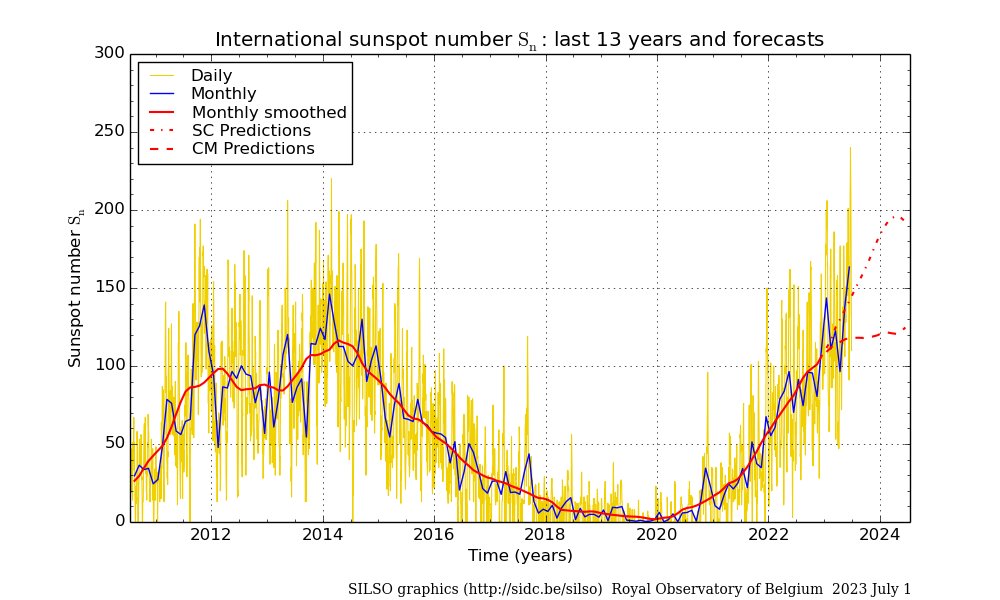
Sunspots surge to highest levels in over two decades, raising concerns of severe space weather
The sun has seen a remarkable surge in sunspot activity, with over 160 sunspots recorded in June. This figure marks the highest monthly number in more than two decades, signaling a significant increase in intensity in the current solar cycle, known as the 25th cycle since records began. These unexpected developments have sparked concerns among experts at NASA and the U.S. National Oceanic and Atmospheric Administration (NOAA) regarding the potential for severe space weather events in the coming months and years, Space.com reports.
Initial predictions from NASA and NOAA had projected a maximum monthly sunspot count of 125 during the peak of the 25th solar cycle. However, the current trajectory indicates that the sun's activity is likely to reach just under 200 sunspots per month, with some scientists suggesting that this peak could be achieved within a year.
Renowned solar physicist Keith Strong shared the striking data on Twitter, stating, "Highest monthly average sunspot number since September 2002! The June 2023 [sunspot number] was 163.4, the highest value for over 20 years."
On July 2, one of these sunspots generated a powerful solar flare, an energetic burst of light. The flare caused a temporary radio blackout in the western United States and over the Pacific Ocean, according to Spaceweather.com. As the solar cycle progresses towards its maximum, such events may become increasingly common.

Contrary to initial forecasts, this heightened sunspot activity may result in not only more solar flares but also more coronal mass ejections (CMEs), which are powerful eruptions of charged particles forming solar wind. Consequently, adverse space weather conditions on Earth could be amplified. Intense solar wind bursts can penetrate Earth's magnetic field, supercharging particles in the atmosphere and triggering captivating aurora displays. However, they can also pose serious problems for power grids and satellites in Earth's orbit.
Tom Berger, a solar physicist and director of the Space Weather Technology Center at the University of Colorado, Boulder, highlighted the potential risks. After a major solar storm in October 2003, satellite operators lost track of numerous spacecraft for several days due to increased gas density in the upper layers of the atmosphere, particularly within the low Earth orbit region where satellites and the International Space Station reside. As the atmosphere expands in response to solar wind interactions, satellites encounter heightened drag or resistance.
Berger explained, "In the largest storms, the errors in the orbital trajectories become so large that, essentially, the catalog of orbital objects is invalidated. The objects can be tens of kilometers away from the positions last located by radar. They are essentially lost, and the only solution is to find them again with radar."
Experts are concerned that the growth in satellite numbers and space debris fragments since the last significant solar storm could lead to orbital chaos lasting for weeks. This period would carry an exceptionally high risk of dangerous collisions with space debris fragments, further endangering satellite operators.
Instances of early space weather troubles have already been observed, such as SpaceX's loss of 40 new Starlink satellites during a seemingly mild solar storm in February 2022. These spacecraft burned up in Earth's atmosphere when they couldn't achieve their intended orbits after launch due to unforeseen drag. The European Space Agency (ESA) also faced issues last year when its three Swarm satellites, responsible for studying Earth's magnetic field, experienced unprecedented altitude loss. Operators had to utilize the satellites' thrusters to prevent them from falling into denser regions of the atmosphere.
- Related News
- Wheel of Death: new method will help astronauts stay fit in low gravity
- Due to anomalies of Orion spacecraft, lunar exploration program may be delayed for years։ NASA
- TAO Observatory: World's highest telescope to study evolution of galaxies and exoplanets
- Powerful M9.5 solar flare causes radio blackout in Pacific Ocean
- What will happen to the Earth if the Moon disappears?
- Key to conquering the Red Planet: Why is NASA studying solar storms on Mars?
- Most read
month
week
day
- Digital Julfa Network is launching a pan-Armenian centre in the metaverse, on the Fastexverse virtual platform 1011
- Xiaomi unveils exclusive Redmi Note 13 Pro+ dedicated to Messi and Argentina national team 895
- Sparkles: Boston Dynamics unveils a furry robot dog that can dance (video) 842
- Internet 500 times faster than 5G tested in Japan: It allows to transfer five movies in HD resolution in one second 726
- Is there a ninth planet in the solar system? Scientists find new evidence 708
- What will happen to the Earth if the Moon disappears? 703
- iPhone 16 may get colored matte glass back panel, 7 colors 683
- How to understand how protected a smartphone is from water and dust? 674
- Which smartphones will be the first to receive Android 15? 656
- Great value for money: 3 best Realme smartphones 650
- Archive
